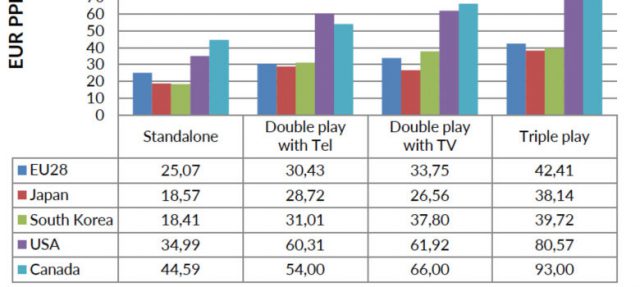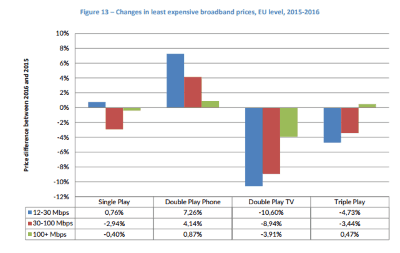
Prices in €. (Source: European Commission)
The European Commission’s latest study on broadband pricing shows while Europe and Asia offer consumers affordable broadband, North American providers are forcing Americans and Canadians to essentially pay twice as much for equivalent levels of service.
Just as was the case in 2015, the report found some of the most costly broadband packages in the world are sold to customers in Canada and the United States. This year, the study found the average Canadian paid more than $52 a month for standalone broadband, in the U.S. an average of $42 a month. In contrast, Europeans paid an average of $30 and Asians paid $22 a month for comparable service. Customers in the U.S. and Canada with a triple play bundle package of broadband, TV, and phone service paid more than double what their counterparts in Asia and Europe did last year.
As U.S. and Canadian providers raise broadband speeds and constrict the number of service tiers they offer, customers are forced into more expensive tiers, whether they need or want them. That further exacerbates the digital divide based on broadband affordability.
In Europe, competition in many EU member states has caused prices to drop for some types of service. Double and triple play packages offering 100Mbps or less declined in price by as much as 10.6% in 2016.
The study found:

Broadband prices for budget tiers actually dropped in Europe last year.
For the download speed basket 12-30Mbps, the EU vies with Japan and in some cases Korea showing the least expensive prices in one or more of the four service bundles. The lowest price for Double Play with fixed telephony in the €28 is also the lowest compared to all the countries analysed. The EU, Japan and South Korea have relatively similar prices when compared with Canada and, in particular, the USA.
Comparing the €28 with other countries in the world, the pattern in the 30-100Mbps speed basket is similar to the 12-30 Mbps basket. Japan is the least expensive country for three of four bundles; only Single Play is slightly less expensive in South Korea. Here, the EU28 just fail to present the lowest price for Double Play with fixed telephony. Again, the EU, Japan, and South Korea stay at more or less close compared to Canada and the USA. Alternatively, Canada is the most expensive country in three of four bundles. However, USA shows the most expensive Double Play with fixed telephony – despite considering the lowest price offers in three States there.
With regard to the 100+ Mbps basket of advertised download speeds, Japan and South Korea are decisively the least expensive markets, across all service bundles. South Korea has the least expensive offer for Single Play, Japan for Double Play including TV services. For the top download speed basket, the EU lies in mid-field between the low-cost Asian and the high-priced North American countries.
Other conclusions:
• Ultra-fast broadband offers (100+ Mbps) were still most expensive in the USA and Canada
• The least expensive offer for South Korea across all bundles was faster than 100Mbps
• Compared to Japan and South Korea, European citizens have to pay similar prices for offers of up to 100Mbps, but significantly more for ultra-fast connections.


 Subscribe
Subscribe
Do we know if the lower costs overseas are a result of Government subsidies? Out of pocket costs are not the only costs. Is higher tax revenue overseas (on other things – income, alcohol, etc.) being used to subsidize the cost of internet connections?
I get your point, but remember we subsidize our companies so it would be really difficult to work that in. We spend billion upon billions handing these companies money so they can overcharge and under-serve. No defense is required for these crooks. It simply comes down to greed and getting away with what they can get away with since they under regulated monopolies or duopolies.
You might consider density and geography as a factor. Canada and the US are far different.
Japan 873 per sq mile
S Korea 1272
US 85
Canada 8